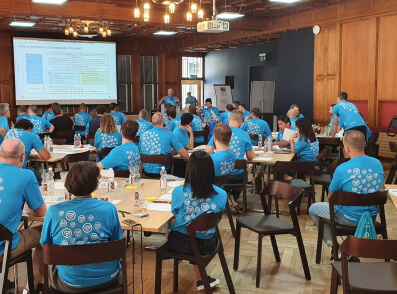Key Takeaways
- Diversify your digital marketing efforts to reach potential customers across various channels.
- Strike a balance between growth and profitability by effectively managing Customer Acquisition Costs (CAC).
- Leverage partnerships and data-driven targeting to keep up with customer trends and tap into new customer bases.
The present-day retail landscape is a far cry from the predictable patterns of the past. Retailers who fail to continuously acquire new customers risk losing market share to more agile competitors. However, simply increasing acquisition spend is not the answer — efficiency is key. This guide outlines seven approaches to customer acquisition that balance growth objectives with Customer Acquisition Cost (CAC) management, helping retailers navigate the complexities of modern consumer interest.
1. Digital Marketing
A strong online presence is fundamental to customer acquisition, engagement and retention. Optimize your website and product pages to rank higher in search results, making it easier for potential customers to find your brand. Run targeted pay-per-click (PPC) ads on search engines and social media platforms to reach potential customers based on their interests and behaviors. Create valuable content, such as blog posts and videos, that addresses customer pain points, attracting organic traffic. Build a strong social media presence by sharing engaging content, running promotions, and interacting with potential customers.
2. Influencer and Affiliate Marketing
Harness the power of influencers and affiliates to expand your reach. Collaborate with influencers who have a large and engaged following in your retail niche to promote products and attract new customers. Establish an affiliate program where bloggers, influencers, and other third parties earn a commission for driving sales to your website. Create campaigns that allow influencers to showcase your products authentically, such as through product reviews or lifestyle content. Measure the effectiveness of these partnerships by tracking key metrics and using these insights to refine your customer acquisition strategy.
3. Promotions and Discounts
Strategic promotions can attract new customers without necessarily impacting your bottom line. Offer special discounts or free gifts to first-time customers to incentivize their initial purchase. Create a sense of urgency with limited-time offers, flash sales, or seasonal discounts to attract new customers. Consider offering product bundles at a discounted rate to entice new customers to try multiple products.
4. Partnerships and Collaborations
Expand your reach through partnerships. Collaborate with complementary brands for joint promotions or product launches, reaching a broader audience. Go beyond traditional partnerships and take a more holistic stance — collaborate with platforms that offer special promotions or offers that align with your customers’ needs.
According to Accenture, 66% of people who felt the pandemic changed them (50% of the market) said they now expect brands to take more responsibility in motivating them to live by their values. Consider integrating health and wellness initiatives through partnerships with platforms like dacadoo DHEP to attract consumers who now shop with well-being in mind.
5. Referral Programs
Leverage your existing customer base to acquire new customers. The Edelman Trust Barometer found that 63% of consumers trust recommendations from friends and family, making it one of the most trusted forms of marketing. Encourage current customers to refer friends and family by offering incentives such as discounts, free products, or store credits. Incentivize customers to share their purchases or experiences on social media, reaching more potential customers.
6. Customer Experience
Create exceptional experiences to turn new customers into loyal ones. Ensure that the online shopping experience is seamless, with easy navigation, quick load times, and a straightforward checkout process. If you have brick-and-mortar operations, provide a memorable in-store experience with helpful staff, an inviting atmosphere, and efficient service to encourage repeat visits. Offer personalized assistance, either online through chatbots or in-store, with trained staff to help new customers find products that meet their needs.
7. Data-Driven Targeting
Utilize data to optimize your acquisition efforts and manage CAC. Use data analytics to identify and target potential customers who are most likely to convert based on their online behavior and demographics.
Then, use predictive analytics to forecast which new customers are most likely to convert and target them with personalized marketing efforts. According to McKinsey, companies that excel at personalization generate 40 percent more revenue from those activities than average players. Platforms like dacadoo are a value-add for your retail offering and can also provide insights into customer preferences, allowing for more targeted acquisition strategies.

Examples and Case Studies
Warby Parker: Personalization Strategy Boosts Customer Base
Warby Parker, an eyewear brand, demonstrated the power of personalization in digital marketing to drive customer acquisition. The company’s try-before-you-buy approach, combined with its online style quiz offering personalized frame recommendations, created a tailored shopping experience that resonated with consumers. This contributed to its customer growth, with active customers increasing by 4.5% to 2.39 million in Q2 2024. Warby Parker’s focus on personalized digital experiences, alongside their expanding physical retail presence, led to a 13.3% year-over-year increase in net revenue.
Specsavers: Tapping TikTok Acquires a New Generation of Customers
Another eyewear retailer, Specsavers, was facing a decline in their traditional customer base and turned to social media to acquire a new, younger demographic of customers. Specsavers partnered with TikTok to develop a tailored customer acquisition strategy. They created six custom, native-style video assets featuring creators and educational content designed specifically to appeal to and engage this younger audience. As a result, the campaign acquired new customers at a cost 30% below the target Cost Per Acquisition (CPA). The most platform-native content, utilizing TikTok’s “Video Reply” feature, also drove 23% of new customer acquisitions.
HelloFresh: Data-Driven Modeling Reduces CAC
HelloFresh, a leading meal kit delivery service, implemented a data-driven targeting approach to optimize its customer acquisition strategy. By developing machine learning models to analyze customer data and forecast Customer Lifetime Value (CLV), HelloFresh made more informed decisions about their marketing spend. The company utilized Google’s target return on ad spend bidding, integrating it with their CLV data. As a result, HelloFresh achieved a 14% increase in return on ad spend and reduced CAC.
Acquiring new retail customers with dacadoo
Attract new customers with dacadoo for retailers. Improve your retail customer acquisition strategy by integrating wellness in with your customer targeting and engagement efforts and create another unique value proposition. Then, use your customers’ health data for more precise customer segmentation and personalized marketing.
Ready to better your approach to customer acquisition? Book a dacadoo demo today and grow your business by creating engaging experiences that attract and retain customers in today’s competitive retail landscape.















